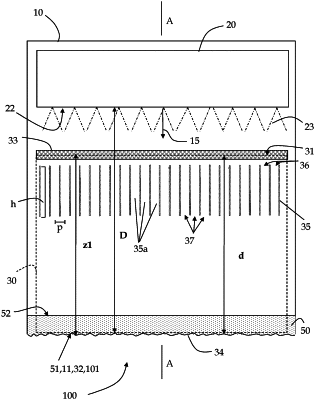| CPC F21V 9/02 (2013.01) [F21V 3/049 (2013.01); F21V 5/004 (2013.01); F21V 11/06 (2013.01); G02B 27/30 (2013.01); F21Y 2105/10 (2016.08); F21Y 2115/10 (2016.08)] | 31 Claims |

|
1. An illumination device comprising:
a direct-light generator that comprises
a collimated light source configured to generate, from a primary light, a collimated light having a spatial modulation, the collimated light exiting an output surface positioned upstream from a first emitting surface from which a direct light is emitted;
a diffused-light generator that is positioned downstream of the direct-light generator and comprises a second emitting surface, the diffused-light generator being configured to emit diffused light at the second emitting surface; and
an optical unit positioned downstream of the output surface of the collimated light source and upstream from the first emitting surface, the optical unit comprising
a first planar light mixing element positioned so as to at least partially intercept the collimated light exiting the output surface of the collimated light source and to define a unit input surface, and
a second planar light mixing element positioned downstream of the unit input surface so as to at least partially intercept the light crossing the unit input surface and to define a unit emitting surface,
wherein the first planar light mixing element is spaced apart from the second emitting surface by a propagation distance d such that, at the second emitting surface, the spatial modulation of the collimated light subtends an angle that is less than or equal to a divergence angle of a response function of the first planar light mixing element.
|